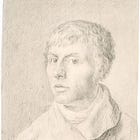What's Your Act of Faith?
Acceptance and Commitment Therapy meets Marina Abramović's radical willingness and committed action
For some time now, I've been reflecting on the idea of an act of faith, not in a religious sense, but in a secular, everyday way.
As a therapist, I encourage my clients to consider what a fulfilling life looks like to them and to take actions, even small ones, that move them toward that life. We often talk about how living meaningfully involves a degree of faith—faith in the unknown, in stepping forward without a clear map of what lies ahead.
Willingness
This kind of faith aligns with the concept of willingness in Acceptance and Commitment Therapy (ACT), a therapy approach that I predominantly practice from. (ACT is read like the verb, not the initials).
I previously discussed willingness here:
Willingness is the intentional choice to approach or experience arising uncomfortable feelings, thoughts, and bodily sensations fully while moving toward what matters to us. In one way, it’s about choosing to be with uncertainty rather than waiting for clarity or control before taking action.
Acts of faith are everywhere
Acts of faith often arise in the midst of personal challenges: willingness to get closer to a new romantic partner after experiencing betrayal, to leave a steady career to start your own business, or to embrace uncertainty with a new medical diagnosis. Faith is found when you choose, despite fears and doubts, to believe in the possibility that something meaningful can emerge.
Being in relationship
One of the most profound acts of faith is the act of connecting with another person. Close relationships, in their truest sense, require vulnerability, trust, and openness. To be in a relationship, we take the leap of faith that the other person will meet us in that space of honesty, even though we can never fully predict how they will respond.
This deep relational faith is mirrored in the work of performance artist Marina Abramović, whose radical commitment to presence and vulnerability offers a parallel to the principles of ACT.
Marina Abramović: radical willingness in action
Known for her endurance-based performances, Abramović pushes the boundaries of physical and psychological limits, fully committing to each experience. She embodies what it means to show up, with mental fortitude and an openness to whatever unfolds.
One of her most famous works, The Artist Is Present (2010), is a prime example of her radical willingness. At the age of 63, she sat silently at the Museum of Modern Art in New York for hours each day over three months, inviting anyone to sit across from her and simply gaze into her eyes.
This act of stillness and openness demanded willingness to be fully present, exposing herself to the emotions and energies of each person who sat before her. In a world where sustained eye contact is often avoided, Abramović created a rare space for true presence.
Abramović described The Artist Is Present in her related documentary (trailer link below) as an intense experience where she felt like a “mirror” to the audience, absorbing their energy and emotions while sitting silently across from them.
Over 850,000 people attended the exhibition, and over 1500 people sat in front of her. The space created an unspoken act of faith between the artist and each participant.
Balancing faith with discernment
While acts of faith can be transformative, not all leaps of faith are equally wise. Faith doesn’t mean ignoring significant risks or disregarding boundaries. Sometimes, an act of faith involves discerning when to trust and when to protect yourself.
For example, choosing to trust someone who has repeatedly betrayed you is different from embracing vulnerability in a relationship built on mutual respect and care. Faith, in its healthiest form, involves both courage and discernment.
In therapy, I encourage clients to cultivate willingness while staying grounded in their values. Faith isn’t about blind optimism. It’s about acting with intention, even when you can’t see the entire path ahead. It’s about trusting that you can handle what comes, even when you can’t control what happens.
For some inspiration, here’s the documentary trailer on Abramović’s exhibition..
Presence as an act of faith
There is one skill that lies at the heart of any healthy person, family, school, community organization, or society: the ability to see someone else deeply and make them feel seen—to accurately know another person, to let them feel valued, heard, and understood. That is at the heart of being a good person, the ultimate gift you can give to others and to yourself.
Offering presence, without distraction or agenda, is one of the most powerful commitments we can make to another human being.
Your act of faith
As you move through today and this week, I invite you to consider what an act of faith might look like in your life.
Embracing uncertainty. Reflect on an area where you can practice willingness to feel the feelings related to uncertainty, despite not having all the answers, whether it's a relationship, career decision, or personal challenge. How does stepping into uncertainty feel?
Letting go of control. Consider how embracing uncertainty might open new possibilities for you. How could releasing control impact your approach to challenges or decisions this week?
Offering presence. Think about a relationship that could benefit from an intentional act of faith, such as reaching out, having a tough conversation, or offering your undivided attention. How might this strengthen your connection?
Or try this: Sit with a friend or partner. Set a timer for a few minutes and gaze at each other. Pay attention to how it feels to offer your undivided attention, without words. Afterward, share what it was like.
What small act of faith will you practice this week?





